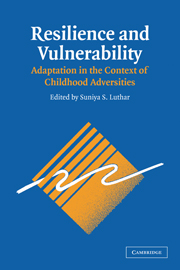Book contents
- Frontmatter
- Contents
- List of Contributors
- Foreword by Dante Cicchetti
- Preface
- 1 A Resilience Framework for Research, Policy, and Practice
- PART I FAMILIAL ADVERSITIES: PARENTAL PSYCHOPATHOLOGY AND FAMILY PROCESSES
- 2 Young Children with Mentally Ill Parents: Resilient Developmental Systems
- 3 Risk and Protective Factors for Children of Depressed Parents
- 4 Resilience and Vulnerability among Sons of Alcoholics: Relationship to Developmental Outcomes between Early Childhood and Adolescence
- 5 Maternal Drug Abuse versus Other Psychological Disturbances: Risks and Resilience among Children
- 6 Resilience to Childhood Adversity: Results of a 21-Year Study
- 7 Sequelae of Child Maltreatment: Vulnerability and Resilience
- 8 Risk and Resilience in Children Coping with Their Parents' Divorce and Remarriage
- 9 Correlational and Experimental Study of Resilience in Children of Divorce and Parentally Bereaved Children
- PART II EXOSYSTEMIC AND SOCIODEMOGRAPHIC RISKS
- PART III COMMENTARIES
- Index
- References
4 - Resilience and Vulnerability among Sons of Alcoholics: Relationship to Developmental Outcomes between Early Childhood and Adolescence
Published online by Cambridge University Press: 05 June 2012
- Frontmatter
- Contents
- List of Contributors
- Foreword by Dante Cicchetti
- Preface
- 1 A Resilience Framework for Research, Policy, and Practice
- PART I FAMILIAL ADVERSITIES: PARENTAL PSYCHOPATHOLOGY AND FAMILY PROCESSES
- 2 Young Children with Mentally Ill Parents: Resilient Developmental Systems
- 3 Risk and Protective Factors for Children of Depressed Parents
- 4 Resilience and Vulnerability among Sons of Alcoholics: Relationship to Developmental Outcomes between Early Childhood and Adolescence
- 5 Maternal Drug Abuse versus Other Psychological Disturbances: Risks and Resilience among Children
- 6 Resilience to Childhood Adversity: Results of a 21-Year Study
- 7 Sequelae of Child Maltreatment: Vulnerability and Resilience
- 8 Risk and Resilience in Children Coping with Their Parents' Divorce and Remarriage
- 9 Correlational and Experimental Study of Resilience in Children of Divorce and Parentally Bereaved Children
- PART II EXOSYSTEMIC AND SOCIODEMOGRAPHIC RISKS
- PART III COMMENTARIES
- Index
- References
Summary
INTRODUCTION
Children of alcoholics (COAs) are at substantially elevated risk for alcoholism in adulthood (Goodwin, 1979; Russell, 1990). Behavioral and cognitive deficits have also been identified as more common in this population (Fitzgerald et al., 1993; Sher, 1991; West & Prinz, 1987) and are of interest as possible mediators of later alcohol abuse and alcoholism. However, simply contrasting COAs and non-COAs does not enhance our understanding of the developmental course leading to such psychosocial outcomes. Although numerous studies have provided evidence for increased rates of alcohol-related difficulties among COAs, some have not observed differences in either drinking behavior or behavioral impairment (Alterman, Searles, & Hall, 1989; Bates & Pandina, 1992; Gillen & Hesselbrock, 1992; Pandina & Johnson, 1989). These discrepancies are likely due to the variable backgrounds of alcoholic parents, the multiple risks they transmit to their offspring, and the individual characteristics of the children. In fact, such discrepancies have increasingly led to the position that the COA population varies on a number of dimensions of vulnerability, and the manner in which the dimensions cluster produces considerable heterogeneity in the population.
In this vein, a number of parental alcoholism characteristics have been linked to adverse behavioral and cognitive child outcomes. Zucker and colleagues (Zucker, Ellis, Bingham, & Fitzgerald, 1996a) have observed that psychosocial outcomes among COAs varied as a function of the presence or absence of paternal comorbid antisocial behavior, with poorer outcomes uniformly present among children whose parent(s) were antisocial as well as alcoholic.
- Type
- Chapter
- Information
- Resilience and VulnerabilityAdaptation in the Context of Childhood Adversities, pp. 76 - 103Publisher: Cambridge University PressPrint publication year: 2003
References
- 44
- Cited by

